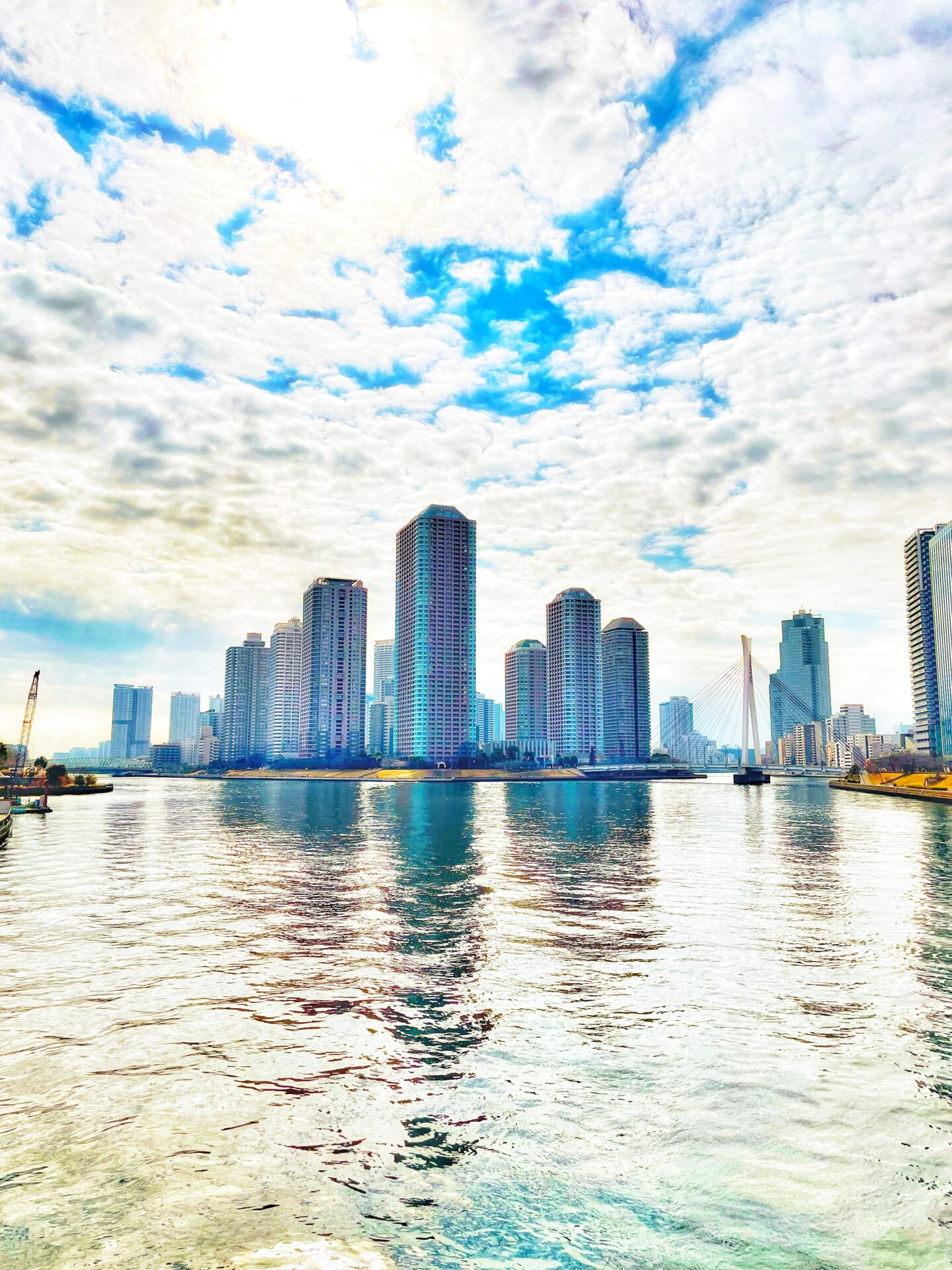The retreat of water
It couldn’t last, of course. Tokyo is a great restless metropolis that has very little sentimentality about its past. And its break with its attachment to water was so complete that Jinnai has declared that the “history of Tokyo since the Meiji Restoration is the history of its transformation from a city on water to a city on land.”
Simply put, two things happened once Edo became Tokyo and the country, under its new Meiji rulers, barrelled full speed into its modern, industrial future.
First, the waterfront areas with their teahouses and other scenes so beloved of ukiyo-e woodblock print artists were the obvious places to site the new industrial facilities (polluting the water, too, into the bargain). And second, the canals themselves became increasingly redundant economically and logistically as other forms of transport, trains included, were developed, although water buses kept plying some of the waterways until well into the prewar period.
It wasn’t until 1964, though, that the canals sunk into literal obscurity. The occasion was the Tokyo Olympics, the city’s great coming out party to the world just two decades after the end of WWII.
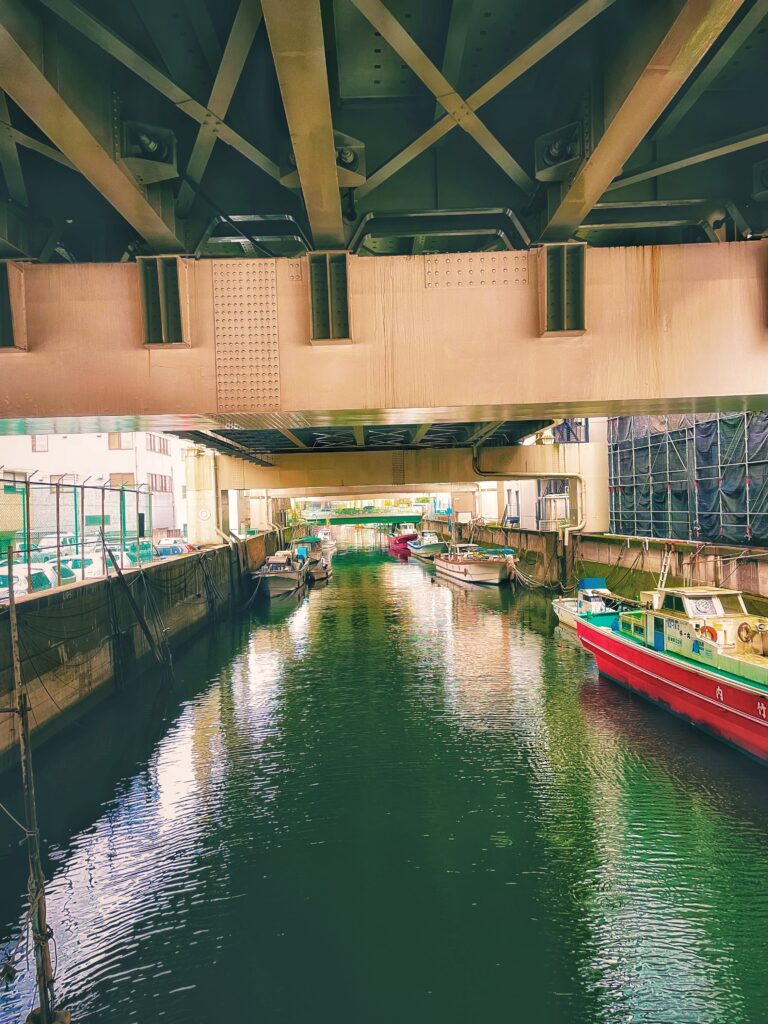
The face that it wanted to show was a modern one, symbolized for instance by Kenzo Tange’s futuristic Yoyogi National Gymnasium. Bullet trains had just started their lightning-fast runs across the country. And now, perched on great concrete pillars 20 or 30 feet above the old canals, or simply taking their place and running in their beds, were the city’s new expressways.
The saddest example is the Nihonbashi canal, one of the most important waterways of Edo, and its bridge, an elegant stone structure built in 1911 that still marks the point from which all distances in Japan are measured. The expressway looms especially close there, barely 15 or 20 feet overhead, as if to entomb the water below it.
Past and future meet in the bay
Is Tokyo’s relationship with water completely over?
Actually, in Kafu’s “east of the river” districts, there are still quite a few large waterways where people can walk right by the water and cherry trees line many stretches.
But one can also find places where the water itself still feels like a strong presence in the urban fabric. Not surprisingly, this experience is mainly to be had only in the reclaimed islands of the bay, an area that for the most part never existed in Edo.
Much of this reclaimed land is still industrial, or contains port facilities; some of it is given over to modern high-rise office, residential and large-scale shopping complexes; but some parts closer in that were reclaimed in the first decades of the 20th century contain residential districts with relatively low-rise, older housing facing canal-like stretches of water.
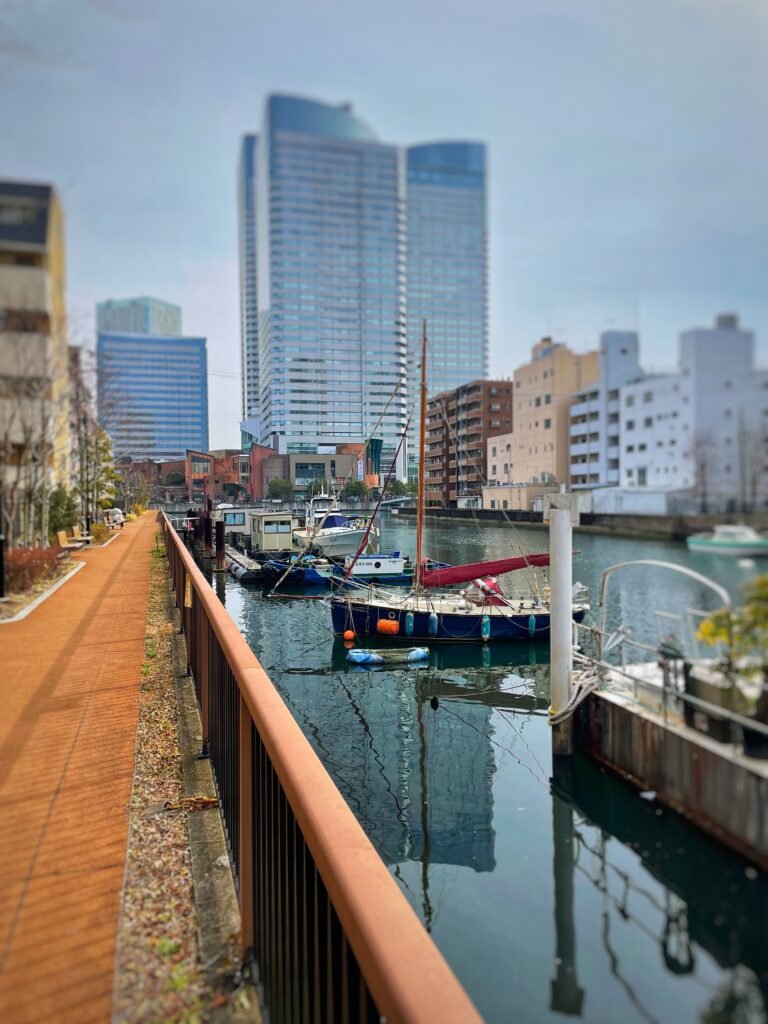
Across from the west bank of the Sumida, what appears to be one island runs from the warehouses of Toyomicho at the southern tip through Kachidoki and then Tsukishima to Tsukudajima in the north. In fact, there is no single island here, at least one with a name, but rather four distinct sections. Two of them, though, do have the word “island” (shima or jima) in their names — Tsukadajima and Tsukishima.
What drew me there was all the blue on the map showing the waterways that divide up the four districts and separate them from the next section of reclaimed land (Harumi) to their east. And besides, I used to look out on this strip of land across the river from a building where I work, long wondering what it was like, but only able to see the warehouses of Toyomicho. Eventually, I explored it in a handful of lunchtime trips and then, with K, as part of a big walk from the old shogunal funereal temple of Zojoji in Daimon to Monzen Nakacho.
On this “island,” oldish apartment blocks, many just a handful of stories high, look out onto greenish, still water that divides up the area into mini-islands, a little like, well…Venice, if one is prepared to use some imagination. (This is a skill that one learns here; perfecting the ability to narrow down the visual frame to the essence of some scene, to exclude surrounding visual noise or clutter, is the key to appreciating beauty in this city.)
Each time I passed, a few residents on benches were looking out, too, and that is the beauty of the water here, where the surroundings are on a small-enough scale not to reduce it to the insignificance it has in other parts of the bay’s reclaimed land.
Here, the water lends itself to dreamy contemplation, and if one is lucky, one might even hear the soothing chug of a boat’s engine as it passes slowly by.
And at least some of the residents appear to make their living from the water. There were boats tied up everywhere and even a boatyard on one waterway. Some of the boats were smallish, roofed tour boats that one sometimes sees out on the river; some were dredging vessels; and some, too, small private motorboats. Walking at the side of this water felt very removed from the hustle and bustle of central Tokyo, all while still remaining within the boundaries of its central-most ward, Chuo.
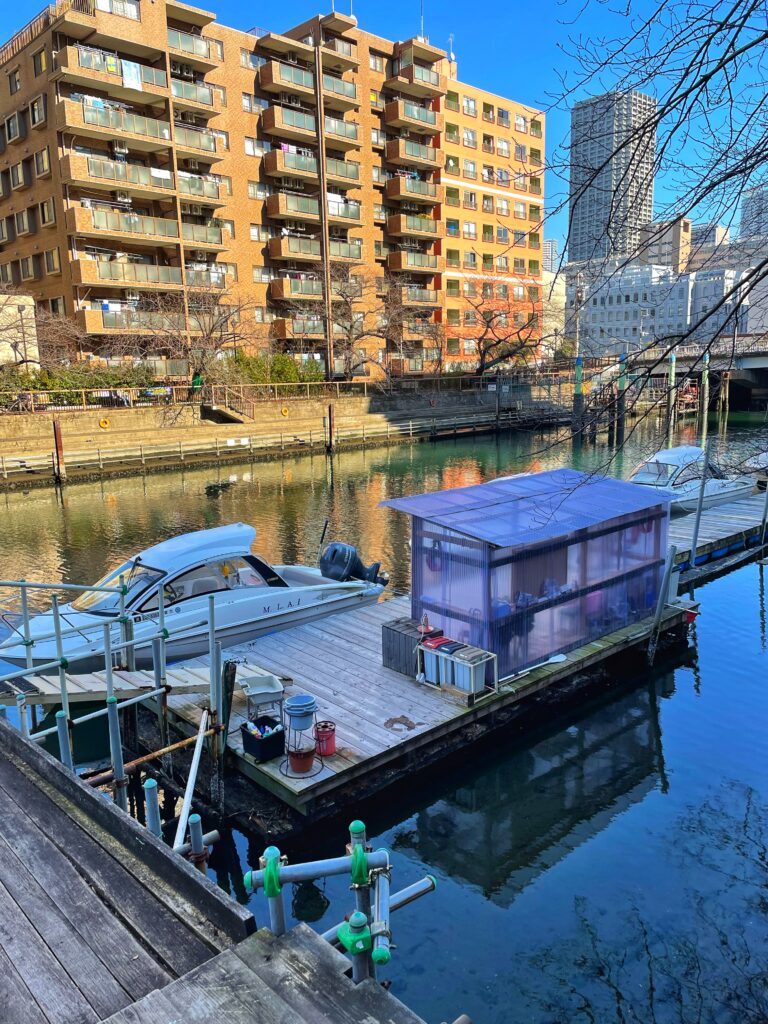
It was ironic, of course, that I should have found the loudest echoes of Tokyo’s former Venice-like aspects in a part of the city whose very existence owed to that process of “transformation from a city of water to a city on land.” But having found those echoes, what then began to interest me most about this “island” was how, in its four districts, it retained traces of almost the entire history of land reclamation in the bay — one of the key mechanisms of the water-to-land process that Jinnai described.
The fishermen’s isle
Toward the tip of the “island” is the extraordinary area of Tsukudajima. When the first Tokugawa shogun, Ieyasu, decided to build Edo in the early 17th century, this was nothing more than one of two sandbars at the mouth of the Sumida River (which has now moved some mile and a half downstream).
But it, and the other sandbar, were quickly built up into artificial islands. They became, in fact, the first artificial islands in the bay but also the last for several hundred years (reclamation of land to add onshore to Edo itself started early and continued — the honour of being the first piece of reclaimed land goes to Hibiya facing the Imperial Palace, which, while now far from the water’s edge, used to be an inlet).
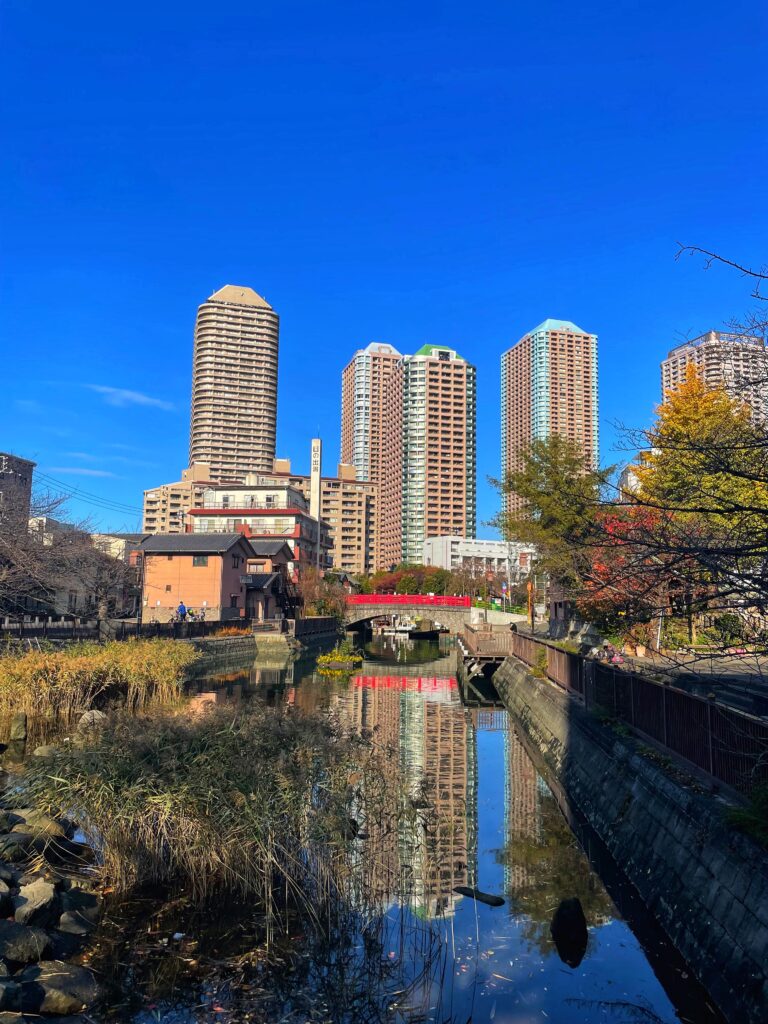
What was Tsukudajima for? The answer is that Ieyasu was paying a debt, and solving a logistical issue into the bargain. The island became the site of a fishing village created for 34 fishermen from what is now the Kansai area near Osaka who had helped Ieyasu escape danger several years earlier.
According to the story, they had appeared with boats to ferry him and his entourage over a river when he was fleeing a coup attempt by a rebel general against Japan’s then military supremo Oda Nobunaga, to whom Ieyasu was allied. The reward for the fishermen was the right to fish freely and without impositions in Edo Bay, and to provision the castle and fill the city’s fish markets.
One of the first things one notices when entering this area is that it still feels like a village. It’s a place of small houses and narrow lanes, made compact and discrete by a waterway that surrounds it, looping in from the Sumida.
The water is crossed by a pretty red bridge; it ends in a muddy flat where one can imagine fishing boats were once hauled in. Backing onto this watery boundary at the far end is a delightful little Sumiyoshi shrine, whose gods are traditionally linked to the sea and sailing. It’s not hard to imagine that the shrine, which is still the site of a summer festival, was once the heart and soul of the area.
Groups of kids were running around the surrounding streets when we were there, though many might have come from the huge apartment complexes that rear up beyond Tskudajima at the very tip of this long strip of reclaimed land.
There is even an old-style dagashiya shop in the neighborhood selling traditional sweets and toys for kids, an increasingly rare sight in Tokyo. It’s all so quaint, in fact, that the area, on the day we visited, had drawn some curious visitors — several groups of middle-aged ladies in kimono, clustered around guides, listening to an account of the area’s history.
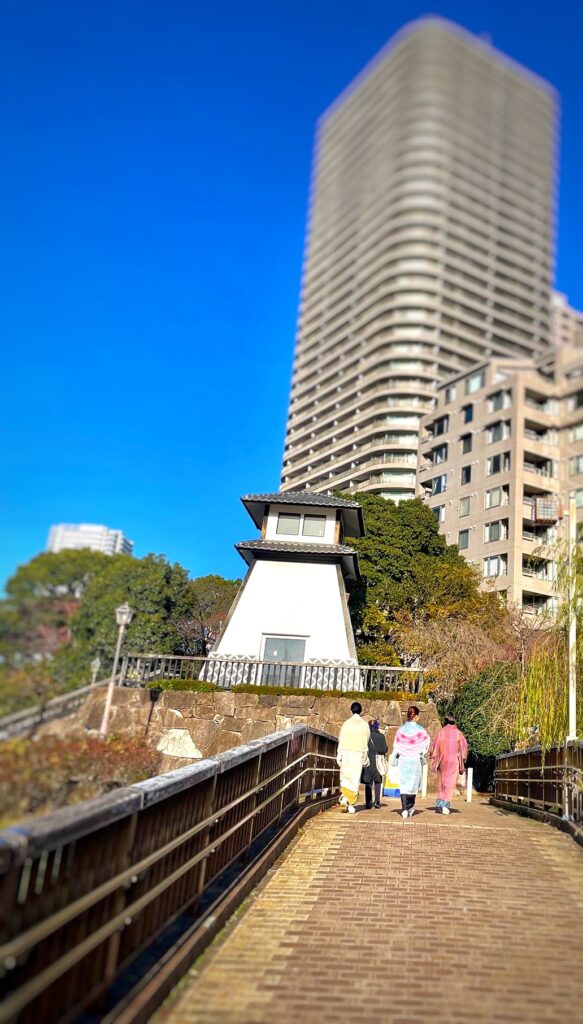
The next thing one notices, with a dawning sense of realization (at least in my case) is that there are several shops selling tsukudani (tiny fish or shellfish, seaweed or beans, mostly, that have been preserved in soy sauce and mirin and are a common accompaniment with rice.)
Most Japanese probably have at least a rough idea that tsukudani, so ubiquitous in the country, present in almost every bento boxed lunch, started life in a district in Tokyo after which it was named (the name, 佃煮, uses the character for tsukuda in Tsukudajima plus one for “boil” or “simmer”), but still, while I was having my penny-drop moment as she explained this to me, K got a thrill looking around her and thinking “so this is where it all started.”
We went into one shop that had appetizing mounds of a dozen or so types of tsukudani in all its modern variety. The shop’s design is a sleek modern riff on the traditional, but it was founded 180 years or so ago and has passed down within one family; and from a chat with the owner, we learned that he himself and some of the others living in the area trace their own family histories to the original fishing community.
The origin of tsukudani was in the days when the fishermen couldn’t go out due to bad weather, and so needed something to eat themselves until the good weather returned (bad weather would strand them on their island).
Typically made from the leftovers of the catch — hence the tiny fish and mini-shellfish and seaweed — tsukudani was originally just boiled in salt and dehydrated, making it hard and chewy. It probably wasn’t great, but it apparently lasted six months.
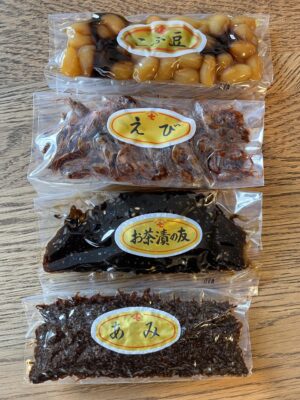
It also wasn’t meant to be sold. That came later, when the Tsukudajima inhabitants began to leave their ancestral trade, discovering instead the extraordinary commercial potential of their rainy-day rations if a few improvements were made.
Soy, mirin and sugar were added, and gradually the tasty side dishes of today were developed, catching on in the rest of Edo and spreading through the country (although similar types of side dishes, with different levels of sweetness or use of ingredients such as ginger to add a sharper tang also arose simultaneously in other parts of Japan).
Continued…
